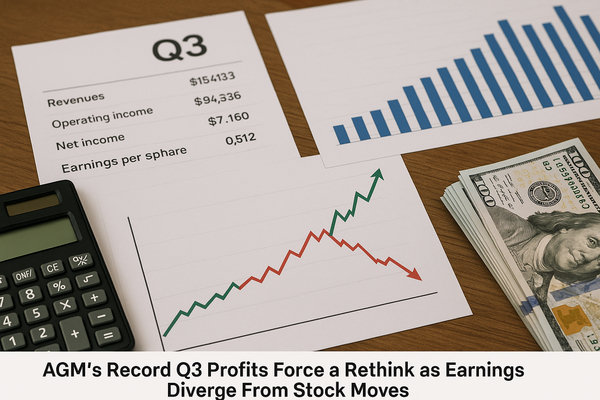
Third-quarter reports this week produced a clear theme: measurable operating progress does not guarantee immediate market reward. Federal Agricultural Mortgage Corporation (AGM) posted what management called record core earnings — net income of $55.0 million for Q3 and $159.49 million year-to-date — and reported material growth in its Infrastructure Finance portfolio. Yet the stock’s year-to-date total return stood at -17.72% in the wake of the report. That disconnect between results and investor response is showing up across capital markets as investors price growth, credit risk and near-term cash generation differently.
Earnings beats that failed to fully persuade
AGM beat both earnings and revenue estimates (earnings surprise +2.03%, revenue surprise +4.04%) while reporting core metrics that management highlighted as evidence of underwriting discipline and spread management. The company’s Q3 non-GAAP profit metrics were consistent with management commentary: Farmer Mac’s reported sales climbed 23% year-over-year to $105.1 million and non-GAAP profit was $4.52 per share in the quarter, while reported net income equated to roughly $4.44 per share on a GAAP basis. Even with those results — and an upgrade from Keefe, Bruyette & Woods noted in the newsflow — AGM’s stock had underperformed, underscoring how valuation and perceived macro risk can mute the typical market reaction to positive earnings surprises.
Credit sensitivity and bank-like dynamics: income versus losses
The tension between rising interest income and rising credit costs surfaced in regional and specialty lenders. OFG Bancorp reported net interest income of $154.72 million and net income of $51.84 million for the quarter, but quarterly net charge-offs increased to $20.2 million. OFG also completed a share repurchase tranche and declared a regular quarterly cash dividend of $0.30 per common share for the quarter ending December 31, 2025. That mix — strong NII and shareholder returns coupled with higher charge-offs — is a reminder that banks and bank-like finance vehicles are being valued on both margin expansion and loan-quality trajectories.
Consumer and retail supply resilience: growth with margin proof points
On the consumer side, two earnings reports illustrated how topline momentum and improving margins can move sentiment when they are clear and quantifiable. Vital Farms delivered a standout quarter with third-quarter sales up 37.2% year-over-year to $198.9 million and GAAP profit of $16.4 million (earnings per share $0.36). The company guided to full-year revenue of approximately $775 million, a figure that anchors investor expectations around growth sustainability.
Hillman Solutions reported Q3 net sales of $424.9 million, an 8.0% increase year-over-year, and non-GAAP earnings of $0.22 per share — 7.6% above consensus — while reiterating full-year net sales guidance and raising FY adjusted EBITDA guidance. Hillman’s Q3 strength — described as a record quarter in the release — shows how distribution and merchandising businesses with operating leverage can convert modest revenue gains into outsized margin improvements. For context, Hillman’s share-price commentary in the dataset placed the stock at $9.28 after recent volatility, with a one-year total shareholder return of about -13.5% noted elsewhere in the company briefs.
Turnaround stories: utilization, fleet optimization and sentiment swings
Hertz provided a textbook example of operational fixes translating into reported profitability and sharp market movement. The rental car company swung to profit for the quarter, reporting sales of $2.48 billion (a 3.8% decline year-over-year) but delivering a non-GAAP profit of $0.12 per share — the company’s first quarterly profit in two years, according to the filings. The market rewarded the result with a 19.1% one-day stock jump; however, the dataset also flagged recent price volatility (a 21% drop over the past month and a 15% decline over three months), illustrating how quickly a recovery narrative can be re-priced when execution questions or macro concerns resurface. Year-to-date returns remained positive on a longer horizon, with the dataset citing a 69.8% total shareholder return for the period prior to the noted weakness.
Commercialization can change the valuation equation
Biotech commercialization is another axis where quantifiable proof points alter investor calculus. Liquidia reported $51.7 million in net product sales of YUTREPIA in the period — the company’s first full quarter of sales-driven profitability — and recorded more than 2,000 unique patient prescriptions with 1,500 patient starts to date. Achieving product revenue at that scale pivoted Liquidia from an R&D story into a commercial one in investors’ eyes and the company emphasized that profitability was achieved in the first full quarter of product sales. That kind of revenue cadence and patient-flow data provides a tangible baseline for forecasting adoption curves and potential upside in the equity.
Valuation and product differentiation in ad tech and software
DoubleVerify’s launch of DV AI Verification™ underscores how product innovation is being used to defend or expand multiples in software and ad-tech. The stock’s recent price action — up 1% over the past month but down 26% over three months — shows investor sensitivity to both cyclical ad spending and the need for new revenue streams tied to AI. When companies can quantify new-product adoption or associated pricing power, markets tend to re-rate multiples; the inverse is true when open questions remain about monetization.
Across these examples, a consistent logic emerges: investors are privileging quantifiable, repeatable drivers — product sales ($51.7 million at Liquidia, $198.9 million at Vital Farms), operating leverage (Hillman’s $424.9 million in net sales and raised EBITDA guidance), and proven turnaround metrics (Hertz’s $2.48 billion in sales and return to EPS profitability) — while simultaneously penalizing businesses exposed to credit or macro risk despite positive operating data (AGM’s $55.0 million Q3 net income and YTD $159.49 million, yet a -17.72% YTD share return; OFG’s $154.72 million net interest income but $20.2 million in charge-offs).
For portfolio positioning, the takeaway is empirical: price moves will increasingly track explicit, verifiable metrics rather than anecdotes. That means monitoring revenue run-rates, EPS conversion, charge-off trends, and product adoption with the same rigor traders apply to headline beats. In this reporting cycle the numbers were decisive — and the market’s mixed responses provide a reminder that execution and clarity of forward guidance remain the clearest paths back to multiple expansion.








